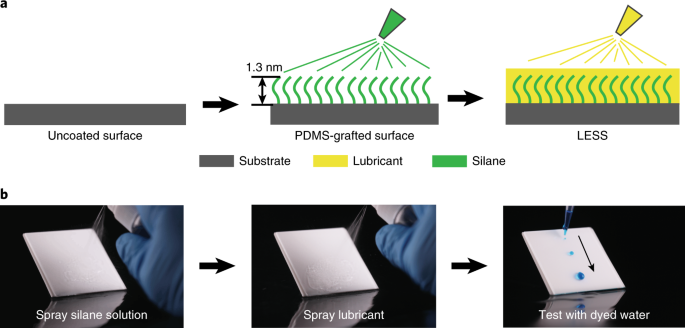
Eliasson, J. The rising pressure of global water shortages. Nature 517, 6–7 (2015).
Mekonnen, M. M. & Hoekstra, A. Y. Four billion people facing severe water scarcity. Sci. Adv. 2, e1500323 (2016).
Attari, S. Z. Perceptions of water use. Proc. Natl Acad. Sci. USA 111, 5129–5134 (2014).
Shannon, M. A. et al. Science and technology for water purification in the coming decades. Nature 452, 301–310 (2008).
Surwade, S. P. et al. Water desalination using nanoporous single-layer graphene. Nat. Nanotechnol. 10, 459–464 (2015).
Chiavazzo, E., Morciano, M., Viglino, F., Fasano, M. & Asinari, P. Passive solar high-yield seawater desalination by modular and low-cost distillation. Nat. Sustain. 1, 763–772 (2018).
Parker, A. R. & Lawrence, C. R. Water capture by a desert beetle. Nature 414, 33–34 (2001).
Ju, J. et al. A multi-structural and multi-functional integrated fog collection system in cactus. Nat. Commun. 3, 1247 (2012).
Park, K.-C. et al. Condensation on slippery asymmetric bumps. Nature 531, 78–82 (2016).
Kim, H. et al. Water harvesting from air with metal-organic frameworks powered by natural sunlight. Science 356, 430–434 (2017).
DeOreo, W. B., Mayer, P. W., Dziegielewski, B. & Kiefer, J. Residential End Uses of Water, Version 2 (Water Research Foundation, 2016).
Human Development Report (United Nations Development Programme, 2006).
Progress on Sanitation and Drinking Water—2015 Update and MDG Assessment (World Health Organization and UNICEF, 2015).
Ghisi, E. & Ferreira, D. F. Potential for potable water savings by using rainwater and greywater in a multi-storey residential building in southern Brazil. Build. Environ. 42, 2512–2522 (2007).
The United Nations World Water Development Report 2016: Water and Jobs (United Nations Educational, Scientific and Cultural Organization & World Water Assessment Programme, 2016).
Mahdavinejad, M., Bemanian, M., Farahani, S. F. & Tajik, A. Role of toilet type in transmission of infections. Acad. Res. Int. 1, 110–113 (2011).
Paterson, C., Mara, D. & Curtis, T. Pro-poor sanitation technologies. Geoforum 38, 901–907 (2007).
Lin, J. et al. Qualitative and quantitative analysis of volatile constituents from latrines. Environ. Sci. Technol. 47, 7876–7882 (2013).
Tuteja, A. et al. Designing superoleophobic surfaces. Science 318, 1618–1622 (2007).
Tuteja, A., Choi, W., Mabry, J. M., McKinley, G. H. & Cohen, R. E. Robust omniphobic surfaces. Proc. Natl Acad. Sci. USA 105, 18200–18205 (2008).
Liu, T. L. & Kim, C.-J. C. Turning a surface superrepellent even to completely wetting liquids. Science 346, 1096–1100 (2014).
Wong, T.-S. et al. Bioinspired self-repairing slippery surfaces with pressure-stable omniphobicity. Nature 477, 443–447 (2011).
Epstein, A. K., Wong, T.-S., Belisle, R. A., Boggs, E. M. & Aizenberg, J. Liquid-infused structured surfaces with exceptional anti-biofouling performance. Proc. Natl Acad. Sci. USA 109, 13182–13187 (2012).
Leslie, D. C. et al. A bioinspired omniphobic surface coating on medical devices prevents thrombosis and biofouling. Nat. Biotechnol. 32, 1134–1140 (2014).
Wang, J., Kato, K., Blois, A. P. & Wong, T.-S. Bioinspired omniphobic coatings with a thermal self-repair function on industrial materials. ACS Appl. Mater. Interfaces 8, 8265–8271 (2016).
Wang, L. & McCarthy, T. J. Covalently attached liquids: instant omniphobic surfaces with unprecedented repellency. Angew. Chem. 128, 252–256 (2016).
Israelachvili, J. N. Intermolecular and Surface Forces (Academic Press, 2011).
Dahlquist, C. A. in Treatise on Adhesion and Adhesives Vol. 2 (ed. Patrick, R. L.) 219–260 (Marcel Dekker, 1969).
Gent, A. & Schultz, J. Effect of wetting liquids on the strength of adhesion of viscoelastic material. J. Adhes. 3, 281–294 (1972).
Wenzel, R. N. Resistance of solid surfaces to wetting by water. Ind. Eng. Chem. 28, 988–994 (1936).
Drelich, J. & Chibowski, E. Superhydrophilic and superwetting surfaces: definition and mechanisms of control. Langmuir 26, 18621–18623 (2010).
Tenjimbayashi, M. et al. Liquid-infused smooth coating with transparency, super-durability, and extraordinary hydrophobicity. Adv. Funct. Mater. 26, 6693–6702 (2016).
Daniel, D., Timonen, J. V., Li, R., Velling, S. J. & Aizenberg, J. Oleoplaning droplets on lubricated surfaces. Nat. Phys. 13, 1020–1025 (2017).
De Gennes, P.-G., Brochard-Wyart, F. & Quéré, D. Capillarity and Wetting Phenomena: Drops, Bubbles, Pearls, Waves (Springer Science & Business Media, 2013).
Preston, D. J., Song, Y., Lu, Z., Antao, D. S. & Wang, E. N. Design of lubricant infused surfaces. ACS Appl. Mater. Interfaces 9, 42383–42392 (2017).
Zhuravlev, L. Concentration of hydroxyl groups on the surface of amorphous silicas. Langmuir 3, 316–318 (1987).
Crisp, A., de Juan, E. & Tiedeman, J. Effect of silicone oil viscosity on emulsification. Arch. Ophthalmol. 105, 546–550 (1987).
Graiver, D., Farminer, K. & Narayan, R. A review of the fate and effects of silicones in the environment. J. Polym. Environ. 11, 129–136 (2003).
Seah, M. P. An accurate and simple universal curve for the energy-dependent electron inelastic mean free path. Surf. Interface Anal. 44, 497–503 (2012).
Liu, H., Zhang, P., Liu, M., Wang, S. & Jiang, L. Organogel-based thin films for self-cleaning on various surfaces. Adv. Mater. 25, 4477–4481 (2013).
Zhang, C., Xia, Y., Zhang, H. & Zacharia, N. S. Surface functionalization for a nontextured liquid-infused surface with enhanced lifetime. ACS Appl. Mater. Interfaces 10, 5892–5901 (2018).
Urata, C., Cheng, D. F., Masheder, B. & Hozumi, A. Smooth, transparent and nonperfluorinated surfaces exhibiting unusual contact angle behavior toward organic liquids. RSC Adv. 2, 9805–9808 (2012).
Rose, C., Parker, A., Jefferson, B. & Cartmell, E. The characterization of feces and urine: a review of the literature to inform advanced treatment technology. Crit. Rev. Environ. Sci. Technol. 45, 1827–1879 (2015).
Woolley, S., Cottingham, R., Pocock, J. & Buckley, C. Shear rheological properties of fresh human faeces with different moisture content. Water SA 40, 273–276 (2014).
Woolley, S., Buckley, C., Pocock, J. & Foutch, G. Rheological modelling of fresh human faeces. J. Water Sanit. Hyg. Dev. 4, 484–489 (2014).
Yunus, A. C. & Cimbala, J. M. Fluid Mechanics Fundamentals and Applications International Edition (McGraw Hill Publication, 2006).
Vickers, A. Water-use efficiency standards for plumbing fixtures: benefits of national legislation. J. Am. Water Works Assoc. 82, 51–54 (1990).
Awad, T. S., Asker, D. & Hatton, B. D. Food-safe modification of stainless steel food processing surfaces to reduce bacterial biofilms. ACS Appl. Mater. Interfaces 10, 22902–22912 (2018).
Halvey Alex, K., Macdonald, B., Dhyani, A. & Tuteja, A. Design of surfaces for controlling hard and soft fouling. Phil. Trans. R. Soc. A 377, 20180266 (2019).
Evans, C., Coombes, P. J. & Dunstan, R. Wind, rain and bacteria: the effect of weather on the microbial composition of roof-harvested rainwater. Water Res. 40, 37–44 (2006).
Segura, C. G. Urine flow in childhood: a study of flow chart parameters based on 1,361 uroflowmetry tests. J. Urol. 157, 1426–1428 (1997).
Yang, P. J., Pham, J., Choo, J. & Hu, D. L. Duration of urination does not change with body size. Proc. Natl Acad. Sci. USA 111, 11932–11937 (2014).
Hennigs, J. et al. Field testing of a prototype mechanical dry toilet flush. Sci. Total Environ. 668, 419–431 (2019).
Lewis, S. & Heaton, K. Stool form scale as a useful guide to intestinal transit time. Scand. J. Gastroenterol. 32, 920–924 (1997).
Source: Resources - nature.com



